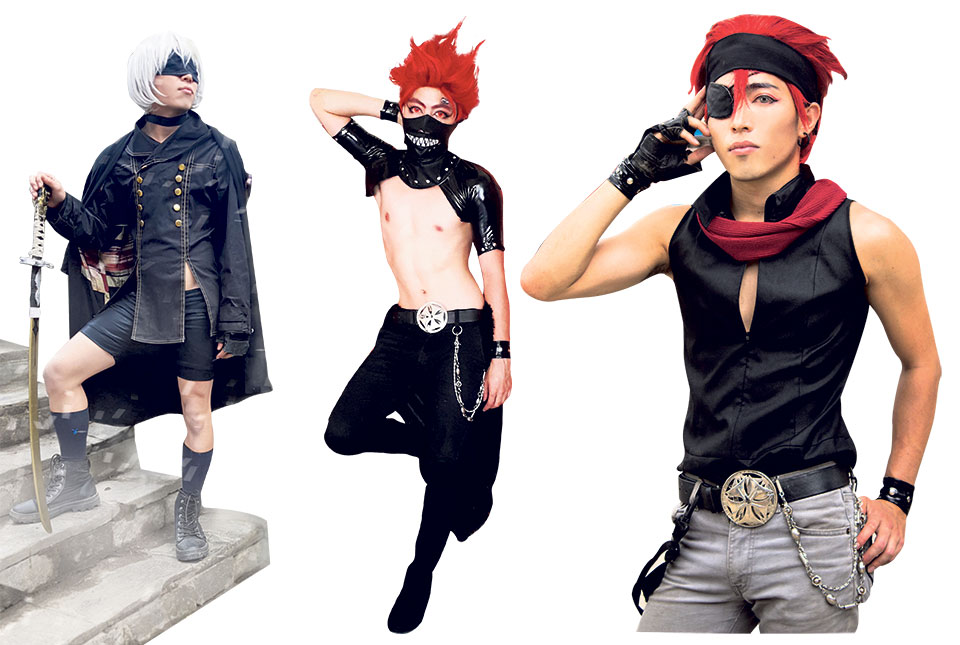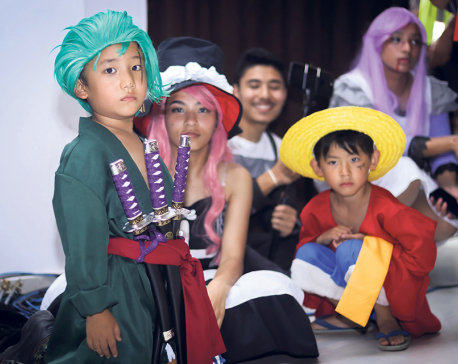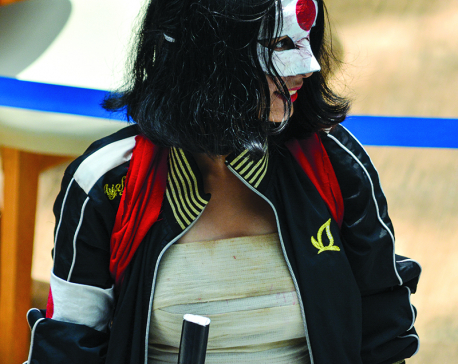
OR

Cosplay in Nepal is mostly hand done. Except for the wigs and lenses that have to be imported, everything is created from scratch. Putting together a look requires mastery over craftsmanship, fabrication, makeup, props designing, wig styling, armor designing, performance, and also acting. Cosplayers also take help from online tutorials but, since Nepal is material-limited, cosplayers have to improvise and substitute materials from local Nepali stores.
You can attend a cosplay event and never know where to look. Whatever theme they may follow, cosplay events are always a grand spectacle of colors, costumes and creativity and getting your fill of everything is tough. In this crowd of players is Wataru Shrestha, perhaps one of Nepal’s most accomplished cosplayers. If you don’t find him dressed up in one of his own characters you will definitely see someone around dressed in one of his creations.
A BFA graduate, Shrestha specializes in creating wearable art that just about includes everything from cosplay to all kinds of crafts. He works as a prop designer, illustrator and artist. Along with his many cosplay events, Shrestha is also the founder of Otaku Store Nepal, the first store in Nepal that specializes in the distribution of anime goods. As of late, he has also started Otaku Club Nepal, a platform that aims to introduce the anime culture to Nepali youths.
Born to a Japanese mother and a Nepali father, Shrestha was raised in a mix of cultures. While most people grew up listening to nursery rhymes he grew up with anime theme songs. “Watching anime and Japanese movies was a huge part of my life,” he says.
As he grew older, Shrestha decided that he would become an artist and it was apparent to him what direction he had to take on his artistic pursuits. His Japanese side played a huge role in how he got his inspiration and work ethic. He drew anime characters, made illustrations for mangas and designed characters from an early age. After completing high school he started focusing on 3D mediums. “I wanted to find a way to bring my imagination to life. So I started with sculptures and eventually discovered the art of cosplay. I fell in love with the very idea of cosplay and have been working with it ever since,” explains Shrestha.
Five years have passed since he first started cosplaying and the thrill of turning into another avatar is the same for him. As the founder of Otaku Club Nepal (that has been in operations since 2014), Shrestha is involved in organizing anime and cosplay events such as the recently concluded Otaku Jatra, art exhibitions, among others. For all these events, Shrestha has acted as a judge, exhibitor, organizer, and participant.
Cosplay in Nepal is mostly hand done. Except for the wigs and lenses that have to be imported, everything is created from scratch. Putting together a look requires mastery over craftsmanship, fabrication, makeup, props designing, wig styling, armor designing, performance, and also acting. Cosplayers also take help from online tutorials but, since Nepal is material-limited, cosplayers have to improvise and substitute materials from local Nepali stores.
“Now that cosplaying is popular, there are stores that import dresses as well but the prices are very high. Cosplayers are mostly students who cannot afford such high expenses so making your own costumes is not a choice but a compulsion,” he says. But Shrestha points out that making your own outfits hones your skills in craftsmanship and creativity. Recently, a team of cosplayers from the club led by Shrestha was invited to Anime Con Darjeeling where they won the competition. The same happened in Anime Con Chennai.
Shrestha observes that the anime–cosplaying scene in Nepal is growing rapidly and creative individuals are getting more opportunities to express themselves through cosplay. “When I first opened the store and the club, there were no platforms for anime lovers to express themselves. Since then I have seen this community flourish,” he notes with delight. Today, there are many stores and organizations dedicated to anime and cosplay enthusiasts and events focusing entirely on anime are being organized on a fairly regular basis.
Although Shrestha has designed and made countless cosplay dresses and props, he focuses on the teaching aspect of assembling a look. He conducts workshops on outfit making because he believes that there are very few people who focus on cosplaying at a professional level. “It’s my goal to make cosplay a professional career in the country rather than just a hobby that a few people pursue,” he shares.
“My education as an arts student has really helped me with my creativity, skills and vision on cosplay and anime,” he says. Cosplay, he adds, is a form of art that includes various artistic processes required in turning two-dimensional characters into three-dimensional forms. By incorporating different mediums of expression such as performance, acting, and drama that are necessary to bringing a character to life, cosplay, he believes, has helped him have a deeper understanding of art. “This in turn has helped me become a better cosplayer,” he admits.
Explaining why he loves cosplaying, he says, “I fell in love with cosplay because it’s a combination of everything that I want to do and want to become. As an artist I’m very experimental and I like to explore different mediums, techniques and principles. Cosplaying combines different artistic processes—craftsmanship, fabrication, prop design, material understanding, armor designing, make up, hair styling, performance, acting, gestural poses, and more.”
Shrestha adds that this journey of endless exploration is something that he absolutely loves. According to him, there is something new in every cosplay and every character you portray helps you have an open mind about many things such as fashion preferences and character orientation. “I couldn’t imagine doing anything else,” he concludes.
The basics of cosplay
Selecting a character
Cosplayers get inspiration mostly through characters either by their looks, personalities or their background stories. “I believe that good cosplay is not determined by their looks or by the physical resemblance to the character. The whole idea of cosplay is expression and it’s important for the person to connect to the character,” says Shrestha adding that you need to feel and understand the character. Most of the time, characters are role models, someone you look up to and someone you would like to become.
Assembling the outfit
Visualizing the outfit and making a list of everything you need to get for the outfit is the logical next step. Shrestha looks up the character’s default dress and armor. Then he shops for the fabrics, ornaments, and other material he needs to make the outfit. Then he gets the wigs and lenses to match his outfit.
Makeup and styling
Once the dress, armor, weapons, and ornaments are done, practicing makeup is next. Different characters have different makeup styles to match their facial orientation. Styling wigs take a lot of time so it’s important that cosplayers separate some time for this beforehand. Styling wigs is a very integral process in having resemblance to a certain character.
Poses and expressions
Characters have different poses and dialogues that are specific to them. For a cosplayer to look natural, dialogue delivery and posing need to be practiced. Then it is the expressions. Expressions in cosplay are very important as it defines the overall mood and vibe of the character. “You also have to do your fair share of research if you’re doing a stage performance. Look up acts, moves, songs and dialogues of characters that can help you get in character,” concludes Shrestha.
You May Like This

Otaku Jatra: A Junction for Cosplay lover
Bhrikutimandap Exhibition hall, on Saturday, turned into a junction for anime, manga, DC, and Marvel fanatics. Attiring in suits of... Read More...

COMIC CON NEPAL FOR Cosplay Lover
KATHMANDU, Sept 11: Heritage Garden, Sanepa on Saturday became a hub for the fans of Batman, Deadpool, Wonder Woman, Luffy, Shanks,... Read More...

Ever rising fandom for Cosplay
Cosplay, a contraction of costume play, is a rather more common hobby among today’s youth. A broader use of the... Read More...




Just In
- Unified Socialist leader Sodari appointed Sudurpaschim CM
- One Nepali dies in UAE flood
- Madhesh Province CM Yadav expands cabinet
- 12-hour OPD service at Damauli Hospital from Thursday
- Lawmaker Dr Sharma provides Rs 2 million to children's hospital
- BFIs' lending to private sector increases by only 4.3 percent to Rs 5.087 trillion in first eight months of current FY
- NEPSE nosedives 19.56 points; daily turnover falls to Rs 2.09 billion
- Manakamana Cable Car service to remain closed on Friday















Leave A Comment